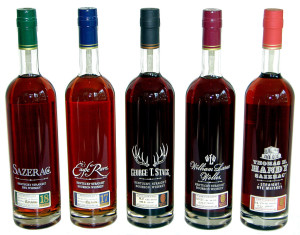The BTAC 2016 Round-Up
How Well Does The 2016 Buffalo Trace Antique Collection Fare Compared To Previous Batches?
By Richard Thomas

One of the most anticipated events of the year among bourbon enthusiasts is the release of the new Buffalo Trace Antique Collection (BTAC), a batch of five distinct whiskeys representing a mix of characteristics. Some are quite old, whereas others are merely mature; some are cask strength; collectively they are drawn from the rye, wheated bourbon, and rye bourbon stocks of Buffalo Trace. Furthermore, while not available on demand, these whiskeys are generally more available than the very elusive Pappy Van Winkle line, and usually cost less too.
Until last year, two staples of BTAC were always the same: Eagle Rare 17 Year Old and Sazerac 18 Year Old. The stock for these whiskeys was transferred into stainless steel tanks, essentially frozen in time, and gradually drawn down over the years. Last year, the tank-based Eagle Rare 17 was replaced by new stock drawn from convention barrel dumps, and this year the same transition happened to Sazerac 18. Now all of BTAC can be expected to vary in quality from year to year, making the question of how this year’s batch measures up more pertinent than ever.
Eagle Rare 17 Year Old (Equal)
Eagle Rare 17 Year Old , with its moderate 90 proof, has traditionally filled the niche as BTAC’s aged, but easy drinking bourbon. This year’s batch is also only the second year running to come from freshly barrel-dumped stock, but the general character and quality of Eagle Rare 17 has nonetheless remained the same. We generally have thought of this as a solid, approachable B+ whiskey over the years, and the 2016 version continues as such.
George T. Stagg (Slightly Better)
Once upon a time, George T. Stagg was almost as hotly pursued as Pappy Van Winkle, and in some circles it still is. Stagg is definitely the most popular of the BTAC whiskeys, and it’s not hard to see why: it’s old; it’s made from a rye bourbon mashbill, a plus for purists; and it’s bottled at cask strength.
At The Whiskey Reviewer, this has been a solidly A class whiskey, hovering in the A and A- range. This year is no exception, although this year’s was noteworthy for being enormously high octane while at the same time not requiring any water added to enjoy. For a 144 proof whiskey, that is remarkable.
Sazerac 18 Year Old (Much Worse)
This is the transition year for Sazerac 18 to go from stainless steel tank stock to freshly dumped stock, and it wasn’t a good transition. Many other observers have noted Sazerac 18 Year Old has taken a turn for the worse in 2016, and we wholeheartedly concur. Until now, no BTAC whiskey has ever received a grade lower than B+ from this website, but Sazerac 18 Year Old 2016 scored a C+ and a B-. Grades like that translate into this year’s release not being worth even the $90 recommended price, let alone a substantial mark up.
Thomas H. Handy (Better)
The annual Handy Rye is a must-have item for the true rye whiskey diehard, probably the best Kentucky style rye bottling available on anything like a regular basis. It’s mature rather than old, but bottled at a very robust cask strength. Generally speaking, rye lovers adore it, while more general whiskey enthusiasts admire it. This year’s Thomas H. Handy is a strong hit even outside of the community of devoted rye lovers.
William Larue Weller (Equal)
Although not as old as Stagg, Weller is a fairly old bourbon, but in particular it comes from the now very esteemed wheated mashbill stock. A different Weller brand whiskey, W.L. Weller 12 Year Old, is often billed as “babby Pappy,” and it is useful to look at the William Larue Weller Bourbon as cask strength “baby Pappy,” because it too is usually a 12 year old.
That said, the quality of the annual William Larue Weller release can fluctuate (2014 was not the best year for Weller, for example), the 2016 release is a strong and typical example of what to expect from this popular bourbon.




Good story. Too short, say it again. Good story.